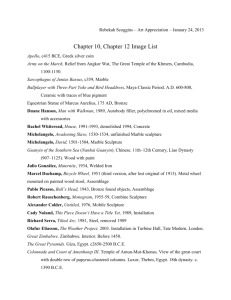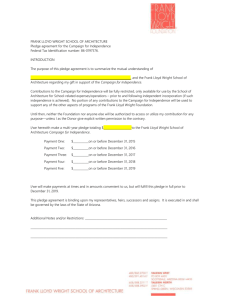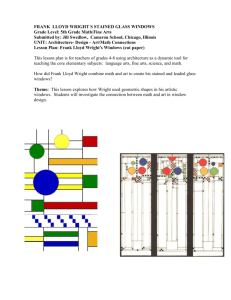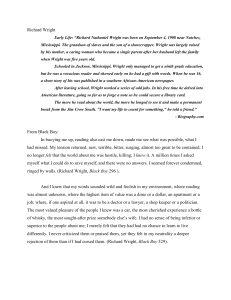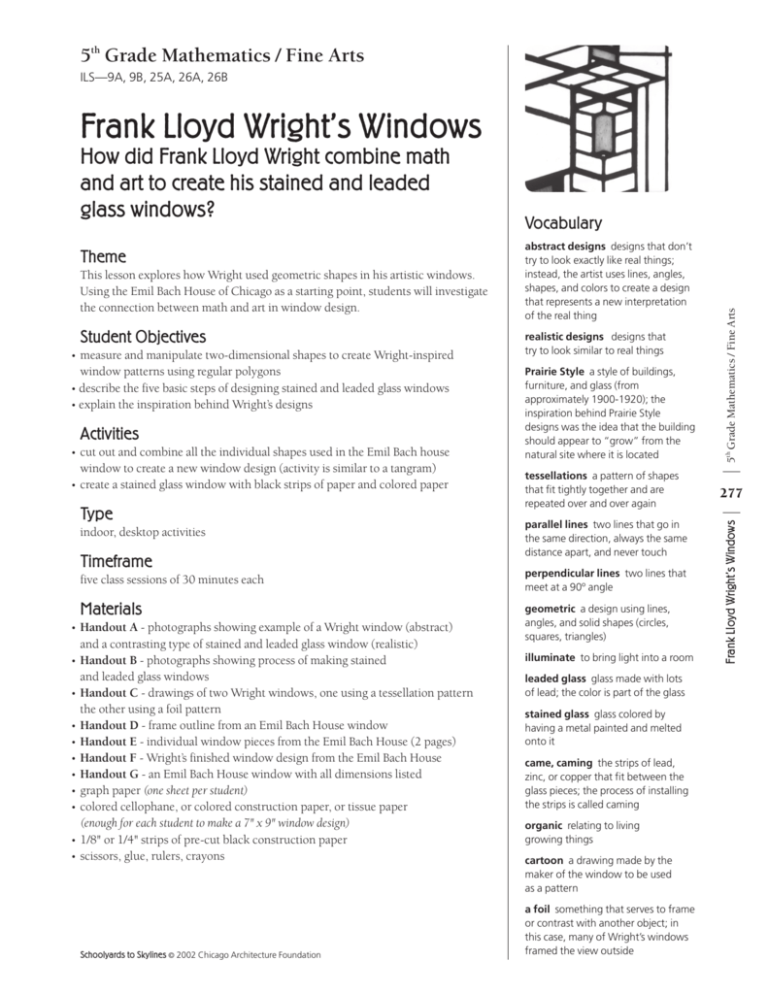
5th Grade Mathematics / Fine Arts
ILS—9A, 9B, 25A, 26A, 26B
Frank Lloyd Wright’s Windows
This lesson explores how Wright used geometric shapes in his artistic windows.
Using the Emil Bach House of Chicago as a starting point, students will investigate
the connection between math and art in window design.
Student Objectives
• measure and manipulate two-dimensional shapes to create Wright-inspired window patterns using regular polygons
• describe the five basic steps of designing stained and leaded glass windows
• explain the inspiration behind Wright’s designs
Activities
•cut out and combine all the individual shapes used in the Emil Bach house
window to create a new window design (activity is similar to a tangram)
•create a stained glass window with black strips of paper and colored paper
Type
indoor, desktop activities
Timeframe five class sessions of 30 minutes each
Materials
•Handout A - photographs showing example of a Wright window (abstract)
and a contrasting type of stained and leaded glass window (realistic)
• Handout B - photographs showing process of making stained
and leaded glass windows
• Handout C - drawings of two Wright windows, one using a tessellation pattern
the other using a foil pattern
• Handout D - frame outline from an Emil Bach House window
• Handout E - individual window pieces from the Emil Bach House (2 pages)
• Handout F - Wright’s finished window design from the Emil Bach House
• Handout G - an Emil Bach House window with all dimensions listed
• graph paper (one sheet per student)
• colored cellophane, or colored construction paper, or tissue paper
(enough for each student to make a 7" x 9" window design)
•1/8" or 1/4" strips of pre-cut black construction paper
•scissors, glue, rulers, crayons
Schoolyards to Skylines © 2002 Chicago Architecture Foundation
abstract designs designs that don’t
try to look exactly like real things;
instead, the artist uses lines, angles,
shapes, and colors to create a design
that represents a new interpretation
of the real thing
realistic designs designs that
try to look similar to real things
Prairie Style a style of buildings,
furniture, and glass (from
approximately 1900-1920); the
inspiration behind Prairie Style
designs was the idea that the building
should appear to “grow” from the
natural site where it is located
tessellations a pattern of shapes
that fit tightly together and are
repeated over and over again
parallel lines two lines that go in
the same direction, always the same
distance apart, and never touch
perpendicular lines two lines that
meet at a 90º angle
geometric a design using lines,
angles, and solid shapes (circles,
squares, triangles)
illuminate to bring light into a room
leaded glass glass made with lots
of lead; the color is part of the glass
stained glass glass colored by
having a metal painted and melted
onto it
came, caming the strips of lead,
zinc, or copper that fit between the
glass pieces; the process of installing
the strips is called caming
organic relating to living
growing things
cartoon a drawing made by the
maker of the window to be used
as a pattern
a foil something that serves to frame
or contrast with another object; in
this case, many of Wright’s windows
framed the view outside
5th Grade Mathematics / Fine Arts
Theme
Vocabulary
277
Frank Lloyd Wright’s Windows
How did Frank Lloyd Wright combine math
and art to create his stained and leaded
glass windows?
1
Teacher Prep
•photocopy or scan Handouts A, B, C, and G for display or projection
•photocopy Handouts D, E, and F of the Emil Bach House window
(one set per pair of students) (do not make double-sided copies)
•photocopy Handout F (one per student)
•cut strips of black construction paper 1/8" or 1/4" wide on a paper cutter or using
a paper shredder (enough for each student to use in a 7" x 9" window design)
Background Information for Teacher
Location Information
1
Frank Lloyd Wright’s Windows
278
Frank Lloyd Wright (1867–1959) is well known for the graceful window designs
in his Prairie Style homes built between 1900 and 1920. There are significant
differences between the window designs of Frank Lloyd Wright and the earlier
window designs for typical Victorian homes and churches. Before Wright, window
designs used colored glass and literal (realistic or representational) pictures to tell
a story or commemorate an event or person. Wright, rather than filling the entire
window section with images, preferred instead to use colored and clear glass to
create a foil or frame through which to view the outside world.
Emil Bach House
7415 North Sheridan Road
Chicago, Illinois
Discussion Points
•
•
What is different about Frank Lloyd
Wright’s window designs from others
of the same time period? (Wright’s
designs were abstract, while many
others of the same time period were
realistic.)
What are some characteristics of each
of these two window types?
Other main ideas about Wright’s window designs:
He never incorporated pictures of people or realistic landscapes. Instead,
he used abstract organic patterns inspired by nature (usually plants).
•
All his windows used geometric shapes applied on a grid system. He primarily
used straight lines, with only a few windows using curves or circles. (Cutting
glass with curved shapes required much more skill and time, and, therefore,
curved designs were more expensive to produce.)
•
Basic steps in making a real
stained or leaded glass window
5th Grade Mathematics / Fine Arts
1. Measure and draw a full-size
pattern on paper. This pattern is
called a cartoon. Decide on colors
for glass pieces.
2. Make another copy of the pattern
and cut out individual pieces of paper.
3. Place a pattern piece on the glass,
and cut around it with a glasscutter.
4. Join the finished cut pieces of glass
with strips of came (usually lead, zinc,
or copper).
5. Install the joined glass pieces
inside a frame by soldering.
• Wright rarely used complex angles or many-sided polygons. His designs used
small squares, rectangles, and triangles.
• Wright’s windows did not block the outside view. His early designs filled in the
entire window with tessellations of one or two shapes, but his most well-known
windows provided a clear glass center surrounded by a complex frame of colored
glass. This type of design, called a foil, framed the outdoor scene, provided protection from the elements, and added privacy without having to use curtains.
• Most used colors inspired by the prairie: greens, oranges, reds, yellows, and gold.
•Wright loved to play with light and color in his buildings. His windows were simply an extension of those ideas. Sometimes Wright’s windows are referred to as “lights” or “lightscreens.”
This lesson uses a window design adapted from the Emil Bach House located
at 7415 North Sheridan Road in Chicago. According to the Historic American
Buildings survey, “This is one of the few houses in the Chicago area done by Frank
Lloyd Wright after returning from Europe in 1911 but before going to Japan to
supervise the work on the Imperial Hotel. It is a late modification of the fireproof
design, published in the Ladies Home Journal in 1906.” Mr. Emil Bach was a coowner of the Bach Brick Company in Chicago. He and his wife Amelia moved into
their new home on Sheridan Road in 1915.
Schoolyards to Skylines © 2002 Chicago Architecture Foundation
photo The Emil Bach House, Chicago. (CAF, 2002)
The Emil Bach House is not open to the public, but one of the windows has been
removed and donated to the Art Institute of Chicago. Currently, the window is
not on display.
Note: Due to the complexity of Wright’s design for the Emil Bach House window,
the pattern used in this lesson has been slightly enlarged and simplified for use
by your students. The dimensions of each glass piece have been modified to be
round numbers. Please also be aware that even though your school’s photocopier is
set at 100%, it may slightly shrink any copies you make. This may be an issue with
your students’ copies of Handouts D - G. Use a ruler to double-check the window’s
overall 7" by 9" dimensions and adjust your copier as needed.
Activity Procedures
day one
Introduction to stained and leaded glass and Frank Lloyd Wright’s windows
“Nothing is more annoying to me than any tendency of realism of form in window-glass,
to get mixed up with the view outside.” - Frank Lloyd Wright, 1928
[5th grade translation: I get annoyed when stained glass windows have pictures of people
or things in them, because the picture in the window gets mixed up with the view outside.]
Display Handout A that shows Wright’s abstract window design alongside
an example of stained and leaded glass with a realistic design not designed
by him. Put Wright’s quotation up on the board and talk about what it means.
Explain some of the main ideas behind Wright’s window designs.
1
Use Handout B to outline the basic process of making a stained glass
window. Reinforce the idea that the process requires both artistic
and mathematical skills.
2
3
Display Handout C that compares an early Wright window using
tessellations with a later style Wright window that acts as a foil.
4
Introduce the vocabulary for the lesson.
Schoolyards to Skylines © 2002 Chicago Architecture Foundation
Social Sciences / Science
Frank Lloyd Wright spent many years
of his life at two homes and studios
he designed. He named them both
“Taliesin.” The original Taliesin was
located near his birthplace in Spring
Green, Wisconsin. Many years later,
he designed Taliesin West for the
desert of West Scottsdale, Arizona.
In both homes, Wright used many
indigenous materials for construction
and design inspiration. Have students
compare and contrast the climate,
flora, and fauna of Wisconsin and
the Arizona desert.
Science
Leaded glass is colored by adding
different minerals and chemicals
to the glass mixture. Students can
research and report their findings
about the connections between
colors and minerals and chemicals.
Suggestions may include copper,
cobalt, or zinc.
279
Frank Lloyd Wright’s Windows
Science
Students can investigate and compare
prairie ecosystems, plants, and
insects with types of plants, insects,
and colors used in Wright’s window
designs. Some of his designs include
wheat shafts, milkweed, sumac,
wildflowers, and butterflies in greens,
oranges, reds, yellows, and gold.
5th Grade Mathematics / Fine Arts
Interdisciplinary
Connections
day two and day three
Math in the windows
5
Review vocabulary and examples of Wright windows and concepts.
Explain to students that they are to create a new window design using the
same shapes that Wright used for a window. Distribute Handouts D and E
to each pair of students. Have the group cut out the shapes on Handout E and fit
and glue them inside the 7" by 9" frame of Handout D. (The process is similar to
working with a tangram.) The group may arrange the pieces in any manner, but
all the pieces must fit within the frame.
6
Resources
Frank Lloyd Wright’s Windows
280
The Smith Museum of Stained
Glass is located at Chicago’s Navy
Pier. It is the first museum in the
country completely dedicated to
stained glass. The museum is free to
the public and contains 150 secular
and religious windows that can
be examined close up. Most were
originally installed in Chicago area
buildings. For more information or
to request a brochure, contact the
museum at 312.595.5024.
Two homes in the Chicago area
that were designed by Frank Lloyd
Wright are open to the public. Call
708.848.1978 for more information
about group tours for either site.
www.wrightplus.org
5th Grade Mathematics / Fine Arts
Frank Lloyd Wright
Home and Studio
951 West Chicago Avenue
Oak Park, Illinois 60622
Frederick C. Robie House
5757 South Woodlawn Avenue
Chicago, Illinois 60637
Frank Lloyd Wright, Ken Burns
and Lynn Novick. VHS, produced
by PBS, 1999.
Frank Lloyd Wright for Kids:
His Life and Ideas, 21 Activities,
Kathleen Thorne-Thomsen. Chicago:
Chicago Review Press, 1994.
Frank Lloyd Wright’s Glass
Designs, Carla Lind. San Francisco:
Pomegranate Artbooks. 1995.
Frank Lloyd Wright’s Stained Glass
& Lightscreens, Thomas A. Heinz.
Salt Lake City, UT: Gibbs Smith, 2000.
Stained Glass Window Designs
of Frank Lloyd Wright, Dennis
Casey, renderings. Mineola, NY:
Dover Publications, 1997.
[Note: You may wish to copy the first page of Handout E onto a colored piece of
paper, and the second page of Handout E onto a different colored piece of paper for
variety and ease of seeing the students’ new window designs. Or the students can
color Handout E before cutting out the window pieces. For this activity only, you
may also want to consider enlarging Handouts E and F to 130% on your copier
machine to fit on an 11" x 17" piece of paper if you feel the pieces are too small
for younger students to manipulate.]
After students have finished cutting and gluing, distribute one copy of
Handout F to each pair to show how Wright used the same the pieces to
create his window design. Compare his window to your students’ work. Remind
students that their designs are not wrong, just another creative way to solve the
problem. Talk about the way Wright organized his window, looking for parallel
and perpendicular lines, geometric shapes, repeating patterns, etc.
7
Using Handout F (copied at 100%) and rulers, have the student pairs
measure and label dimensions for Wright’s window. Each pair can also find
the perimeter or area of the whole window or just some of the shapes you call
for, such as all the triangles, certain rectangles, or all the squares, etc. Check their
answers by displaying Handout G.
8
day four and day five
Art in the windows
Give each student another copy of Handout F that shows Wright’s design
for the Emil Bach House window, and have them use only one crayon to
design the color pattern for the window. Discuss: Which shapes will you highlight?
What happens to the patterns once you begin adding color? Have students compare
designs.
9
Hand out graph paper for students to design their own stained glass window.
You may wish to display pictures of plants, flowers, or trees to spark students’
creativity, or you may choose to go outside and use real plants for inspiration. Allow
them to choose a plant and then design a window using an abstracted (not realistic)
form. Remind students they can use only simple geometric shapes as Wright did.
10
You may choose to set parameters for their window designs, depending on certain
math skills you are studying. Examples: their window must include ‘x’ number of
right triangles, ‘y’ number of 3" squares, ‘z’ number of 2" x 6" rectangles, etc.
Schoolyards to Skylines © 2002 Chicago Architecture Foundation
Working with colored cellophane (or colored construction or tissue paper),
students should cut out pieces that match their patterns. Use the thin pre-cut
black paper strips to represent came strips and glue the window design together.
Note: Their individual pieces will remain the same size as their patterns; however,
the overall dimension of the window will increase somewhat due to the width of
the came strips.
11
When the designs are finished, hang them in your classroom windows to
let the sunlight shine through.
• Create very large versions of Wright-inspired windows with your class. Change
the unit of measurement and let inches from their paper designs equal feet in these
large versions. Using a measuring tape and rolls of masking tape on the gym floor
(or small wooden stakes and brightly colored string on the playground), have
students lay out their designs.
• Rather than having each student make their own window design, combine your
efforts for a group project. Measure your classroom windows, and make a scaled
drawing of the frame. Have students design a Wright-inspired window pattern on
paper. Then, using that design, cover an entire classroom window with cellophane
or tissue paper and black paper dividers.
• Have students design a window that tessellates. Use one of Wright’s early patterns
from his Home and Studio in Oak Park, Illinois seen on Handout C as an example.
9A Demonstrate and apply geometric
concepts involving points, lines, planes
and space.
9.A.2a Build physical models of twoand three-dimensional shapes.
9.A.2b Identify and describe how
geometric figures are use in practical
settings.
9.A.2c Describe and draw
representations of geometric
relationships, patterns, symmetries, and
designs, in two- and three dimensions
with and without technology.
9B Identify, describe, classify and
compare relationships using points,
lines, planes and solids.
9.B.2 Compare geometric figures and
determine their properties including
parallel, perpendicular, similar,
congruent and line symmetry.
25A Understand the sensory elements,
organizational principals and expressive
qualities of the arts.
25.A.2d Identify and describe the
elements of 2- and 3- dimensional
space, figure ground, value and
form; the principles of rhythm, size,
proportion and composition; and the
expressive qualities of symbol and story.
26A Understand processes, traditional
tools, and modern technologies in the
arts.
26.A.2e Describe the relationships
among media, tools/technology and
processes.
26B Apply skills and knowledge
necessary to create and perform in one
or more of the arts.
26.B.2d Demonstrate knowledge and
skills to create works of visual art using
problem solving, observing, designing,
sketching and constructing.
Schoolyards to Skylines © 2002 Chicago Architecture Foundation
5th Grade Mathematics / Fine Arts
Extensions
Illinois Learning Standards
and Benchmarks
281
Frank Lloyd Wright’s Windows
12
Handout A
Frank Lloyd Wright’s Windows
282
Mathematics / Fine Arts
top Window in the Frederick C. Robie House, designed
by Frank Lloyd Wright, Chicago, 1910. (© Hedrich Blessing,
photo by Chris Barrett. Courtesy Frank Lloyd Wright Preservation
Trust. Used with permission.)
bottom View of a church window at Unity Church, North
Easton, Massachusetts. (CAF, 1999)
Schoolyards to Skylines © 2002 Chicago Architecture Foundation
Handout B
1. Measure and draw a full-size pattern on paper. This pattern is called a cartoon. Decide on colors for glass pieces.
Mathematics / Fine Arts
2. Make another copy of the pattern and cut out individual pieces of paper.
3. Place a pattern piece on the glass, and cut around it with a glasscutter.
4. Join the finished cut pieces of glass with strips of came
(usually lead, zinc, or copper).
5. Install the joined glass pieces inside a frame by soldering (pronounced
SAH - der - ing). A soldering iron (shown in the photograph) is used to
heat the metal and permanently join metal pieces together.
Bill Klopsch, a stained glass craftsman in Skokie, Illinois, showing the steps in creating a stained glass window. (CAF, 2002)
Schoolyards to Skylines © 2002 Chicago Architecture Foundation
Frank Lloyd Wright’s Windows
283
Handout C
Frank Lloyd Wright’s Windows
284
Mathematics / Fine Arts
left Drawing of a window in the Frank
W. Thomas House, designed by Frank
Lloyd Wright, Oak Park, Illinois. (CAF, 2002)
top right Drawing of dining room
window in the Frank Lloyd Wright Home
and Studio, designed by Frank Lloyd
Wright, Oak Park, Illinois. (CAF, 2002)
circa 1930. (Wrightiana Collection, The Art
bottom right Frank Lloyd Wright,
Institute of Chicago. All rights reserved.)
Schoolyards to Skylines © 2002 Chicago Architecture Foundation
Mathematics / Fine Arts
Handout D
Frank Lloyd Wright’s Windows
285
Frame outline from an Emil Bach House window.
Schoolyards to Skylines © 2002 Chicago Architecture Foundation
Handout E - page 1 of 2
Individual window pieces from an Emil Bach House window.
Frank Lloyd Wright’s Windows
286
Mathematics / Fine Arts
Schoolyards to Skylines © 2002 Chicago Architecture Foundation
Handout E - page 2 of 2
Mathematics / Fine Arts
(continued) Individual window pieces from an Emil Bach House window.
Frank Lloyd Wright’s Windows
287
Schoolyards to Skylines © 2002 Chicago Architecture Foundation
Handout F
Frank Lloyd Wright’s Windows
288
Mathematics / Fine Arts
Drawing adapted from a window in the Emil Bach House, designed by Frank Lloyd Wright, Chicago. (CAF, 2002)
Schoolyards to Skylines © 2002 Chicago Architecture Foundation
Mathematics / Fine Arts
Handout G
Frank Lloyd Wright’s Windows
289
Schoolyards to Skylines © 2002 Chicago Architecture Foundation



